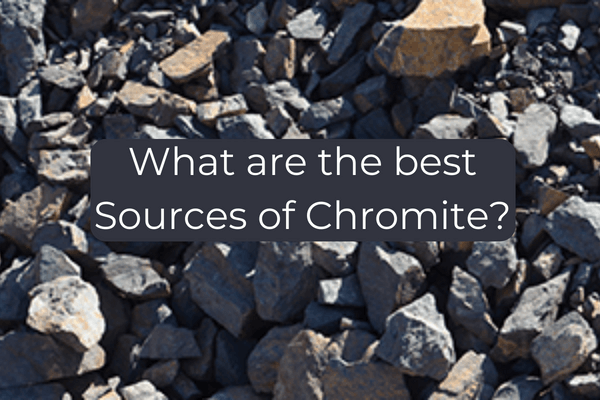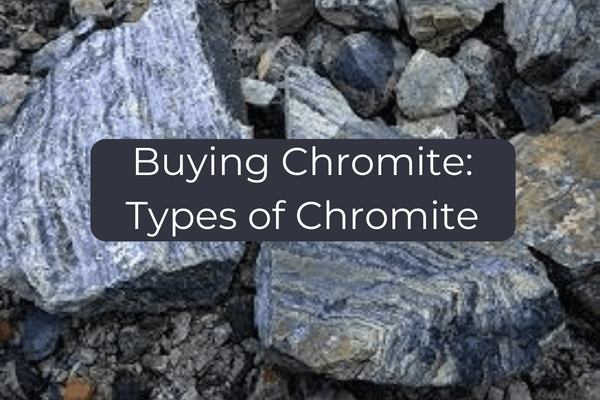Introduction:The Ultimate Chromite Guide
In this ultimate chromite guide we explore Chromite which is an oxide mineral composed of chromium, iron, and oxygen. Its chemical formula is FeCr2O4, and it’s primarily found as a primary constituent in the mineral chromite, which is mined from ultramafic-mafic layered intrusions. When polished, it shines brightly with a dark black or brownish hue, somewhat mesmerizing to look at.
Now, why is Chromite such a big deal in today’s industries? First off, Chromium, which is extracted from chromite, is used to produce stainless steel, which, as we all know, is practically everywhere these days—from your kitchen utensils to the majestic skyscrapers. Moreover, it’s used in the production of ferrochrome, a key component in stainless steel production. Its ability to resist corrosion, high-temperature scaling, and enhance hardenability in steel are just a few reasons why it’s in demand. So let’s dive into the guide:
Iran Chromite Group, a specialized company in exporting chromite worldwide, is suggesting to buy Chromite products from Iran.

What are the best Sources of Chromite
Global Chromite Reserves
So, where’s the mother lode of chromite? Well, buddy, the earth’s crust is generously dotted with this ore. Think of chromite reserves as nature’s hidden treasures, lurking beneath the surface, just waiting to discover them.
Major chromite reserves are found in South Africa. Then, you’ve got Kazakhstan and India. These countries have substantial deposits that play a huge role in the global market. But hey, let’s not forget about smaller players like Turkey and Brazil. Every reserve has its unique characteristics. Iran also has proven reserves stand at about 10 million tons.
Top Chromite Producing Countries
South Africa – no surprise there – tops the list. I mean, they’re the big kahunas in chromite production. Next up, we’ve got Kazakhstan.India follows suit with substantial output, considering its vast reserves.
Turkey and Brazil might not be the main attractions, but they sure have a pivotal role in the global supply chain. Their chromite contributes to various industries, from metallurgy to cosmetics.
Iran possesses 96 mines that extract chromite, and the miners extract 375,000 tons of the mineral annually from its proven reserves of around 10 million tons.

The Ultimate Chromite Guide: Types of Chromite
Metallurgical Chromite
Metallurgical chromite is primarily used in the production of ferrochrome, which, in turn, is a key ingredient in stainless steel production. So, whenever you’re admiring that shiny stainless steel utensil or appliance, you’re essentially looking at metallurgical chromite at work. Pretty neat, huh? This type of chromite has a high Cr:Fe ratio, making it essential in steel alloy production.
Refractory Chromite
Refractory chromite is used in the making of refractories. These are materials that can withstand super high temperatures without melting – like the linings of furnaces and molds. What gets my gears grinding in excitement is the fact that refractory chromite has a low silica content. This makes it perfect for the job since silica, at high temperatures, tends to become all gooey and runny.
Chemical Chromite
Chemical chromite is used to produce chromium chemicals, which are utilized in a bunch of industries – from tanning leather to preserving wood and even dying textiles. Diverse, ain’t it? It’s pretty nifty how one mineral can have so many uses. This type of chromite doesn’t have the high Cr:Fe ratio of its metallurgical sibling, but it does need a certain level of purity.
What are the main factors affecting Chromite’s quality?
Here are the main factors affecting chromite quality:
Chromium to Iron Ratio (Cr:Fe ratio): A higher Cr:Fe ratio is often preferred in the metallurgical industry. This ratio affects the smelting process and the quality of ferrochrome produced.
Impurities: The presence of impurities such as silica (SiO_2), alumina (Al_2O_3), and magnesia (MgO) can impact the smelting process. These impurities can form slag and consume energy.
Silicate Content: Chromite ores with a high percentage of silicate minerals can be less desirable due to increased slag formation during smelting.
Grain Size: The size distribution of the chromite grains can impact beneficiation efficiency. For some metallurgical processes, finer grains might be more desirable, while for others, coarser grains might be preferred.
Physical Characteristics: Features such as hardness, specific gravity, and toughness can affect mining, beneficiation, and smelting processes.
Moisture Content: Excessive moisture can be detrimental during smelting. Chromite ore should be dried before processing.
Total Chromium (Cr) Content: The percentage of total chromium content in the ore is a direct measure of its quality. A higher percentage is usually more desirable.
Country of Origin: Chromite from various countries have varying prices, such as South African chrome ore 42% being pricier than Chrome ore Turkey 42%.
The Ultimate Chromite Guide: Quality Assessment
Determining Chromite Purity
Determining the purity of chromite is paramount. Think of it this way: You wouldn’t want to invest your hard-earned money in a diamond with tons of impurities, would you? The same goes for chromite. A quick method involves assessing the mineral’s color and luster. Bright, metallic shine indicates good purity.
Lab tests are your best bet. They measure the chrome-to-iron ratio, which is a dead giveaway. Ideally, you’d want a 2:1 ratio for metallurgical grade chromite.
Influence of Impurities
Impurities can greatly affect the quality and usefulness of chromite. When there’s too much of something that shouldn’t be there, it can reduce the alloy’s strength and resistance. For example, higher levels of aluminum can lead to reduced ductility in the resulting steel product. Not ideal, right? It’s like getting a chocolate chip cookie and biting into a raisin – unexpected and a tad disappointing.
Recognizing High-Quality Chromite
Apart from the shiny luster I mentioned earlier, the texture and streak can give you clues. A smooth, even surface and a brownish-black streak on unglazed porcelain hint at superior quality. Also, if the sample feels heavy for its size, it’s a good sign! But remember, always – and I mean ALWAYS – get a lab test. It’s the only surefire way to know you’ve got the cream of the crop.
Pricing and Valuation of Chromite
If you’re diving into the chromite market, understanding its valuation is paramount. Let me break it down for you.
Factors Influencing Chromite Price
When it comes to the pricing of chromite, several factors are at play. Naturally, demand and supply reign supreme – it’s the good old law of economics. When there’s a surge in demand for chromite – be it for steel production, foundry sand, or refractory bricks – and the supply can’t keep up, prices skyrocket. Read More:Why Invest in Chromite? Trends and price in 2024
But that’s just scratching the surface! Production costs, like mining and transportation, also play a crucial role. If it costs an arm and a leg to extract and transport the mineral, you bet the price will reflect that. Plus, don’t even get me started on geopolitical factors. Trade restrictions, wars, embargoes… they all create ripples in the chromite market.
Global Price Trends
Over the years, I’ve seen the chromite market go through its fair share of ups and downs. Generally, the trend has been upwards, reflecting the increased demand from emerging economies, especially in Asia. But, just like the weather, the market has its unpredictable moments – so always keep an eye out for those market forecasts! Read more:Understanding Chromite’s Global Demand: Key Trends and Market Analysis in 2024
Chromite Deposits in Iran
Sanctions and Absence of LC
One of the first things you’ll come across when considering Iranian chromite is the issue of sanctions. The political landscape surrounding Iran has, for years, been tumultuous, affecting trade. As a result, many international banks don’t provide a Letter of Credit (LC) for transactions involving Iranian goods.
In Iran, all exporters are utilizing TT payment terms, which refer to cash against documents.
Payment Procedure
Always, and I mean always, ensure you have a clear-cut agreement with your supplier. Some suppliers prefer upfront payments, while others are okay with partial advances. Just remember, transparency is key here. Discuss everything – from currency conversion rates to transaction fees – in advance.
Essential Questions to Ask Suppliers
When dealing with suppliers, there are a few crucial questions you simply must ask. Trust me, it’s better to be safe than sorry. Here are a few to get you started:
- What’s the grade and quality of the chromite you offer?
- Do you provide any guarantees or after-sales support?
- What’s the delivery timeframe?
- Are there any hidden charges or fees?
- How do you handle disputes or concerns?
Ask for Proof and documents
It’s common in the chromite market for someone to claim they have chromite ore for sale, but upon further investigation, it’s discovered that the deposit they’re referring to is owned by someone else. When buying chromite, always request evidence like pictures and videos of the deposit. Before making any payment, request inspection report, SGS report, previous BLs copy to authenticate the seller.
The Ultimate Chromite Guide: How can I ensure I’m getting a fair price?
Now, first things first. Always, and I mean always, base your price checks on reliable platforms. I personally recommend www.ferro-alloys.com. Over the years, this site has proven to be quite dependable in giving current market prices. It saved my bacon countless times when I was negotiating with sellers and buyers.
Another thing to consider – prices tend to wobble a bit depending on how much you’re willing to pay upfront. It’s a nifty little dance between buyer and seller. The more advanced payment you’re ready to make, the better deal you might score. It’s a bit of a give and take, you know?
Storage and Handling of Chromite:
Proper Storage Techniques
First and foremost, it’s vital to store chromite in a cool, dry place. Humidity and moisture? They’re your worst enemies. When exposed to damp conditions, chromite can deteriorate, leading to decreased quality. And I’ve felt the heartache of seeing a perfectly good batch go to waste – it’s no fun, let me tell you.
Now, containers matter too. Always opt for sturdy, sealed containers. Think about it: this helps in keeping contaminants out, ensuring the chromite remains pure. And trust me, the last thing you want is to find your product tainted when you’re about to make a sale.
Safety Precautions in Handling
Always use gloves when handling chromite. Sure, it’s not radioactive or anything, but long-term exposure can cause skin irritations. I remember one time when I forgot my gloves, and after handling chromite all day, my hands were red and itchy for a week. Not a pleasant memory.
Additionally, if you’re handling chromite in its powdered form, using a face mask is a no-brainer. Inhaling chromite dust can lead to respiratory issues. And trust me, having a coughing fit in the middle of a meeting isn’t the kind of impression you want to make.
Last but not least, remember to keep the working area clean and free from chromite residues. After all, clean work is efficient work.
Conclusion:The Ultimate Chromite Guide
The 2023 ultimate chromite guide provides insights into the oxide mineral, Chromite, used mainly in producing stainless steel and ferrochrome. Major reserves are in South Africa, Kazakhstan, and India, with significant contributions from Turkey, Brazil, and Iran. There are three types of chromite: metallurgical, refractory, and chemical. Chromite quality is influenced by its Cr:Fe ratio, impurities, grain size, and origin. Before purchasing, buyers should assess purity, consider geopolitical factors, and verify supplier authenticity.
